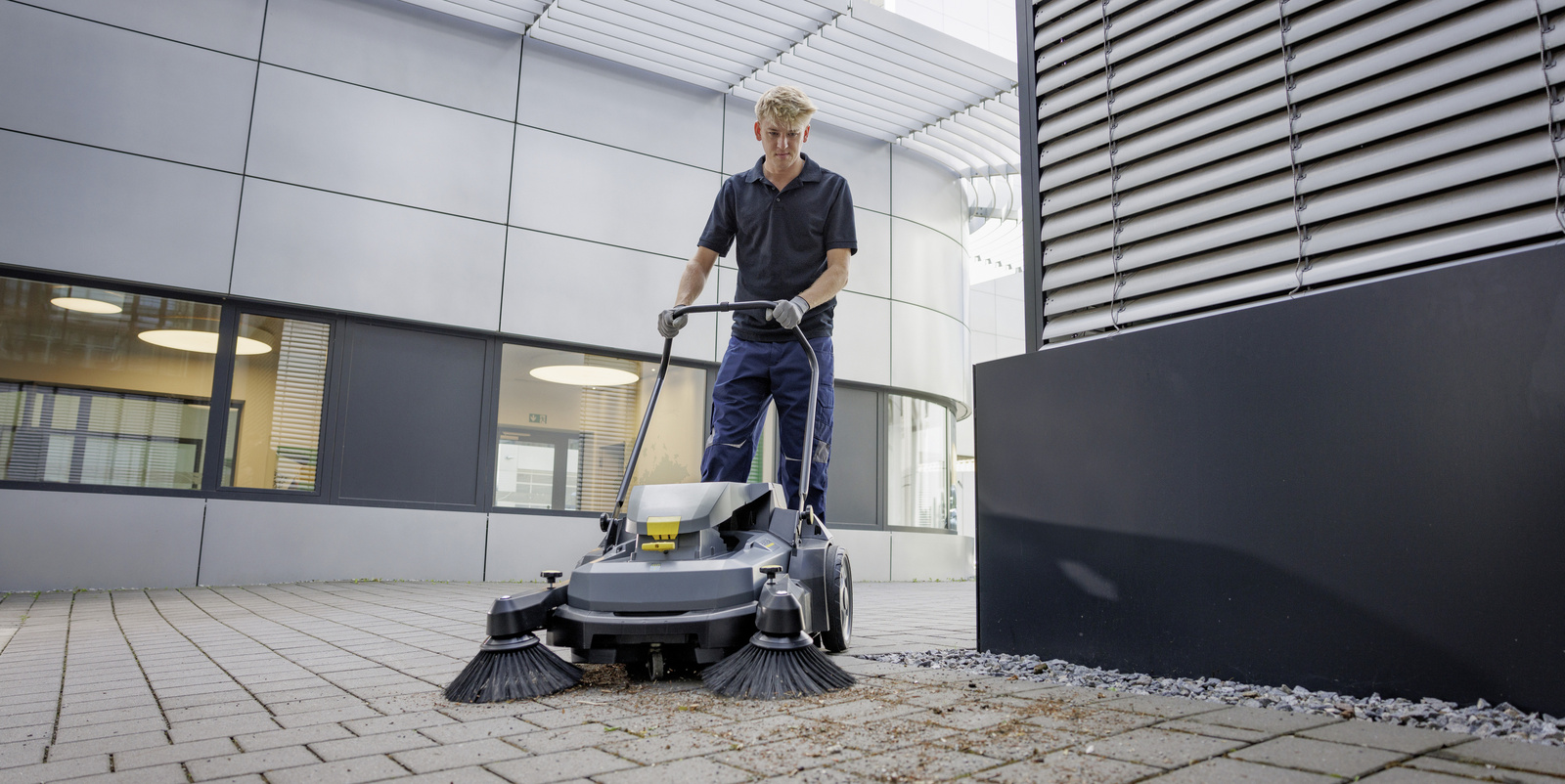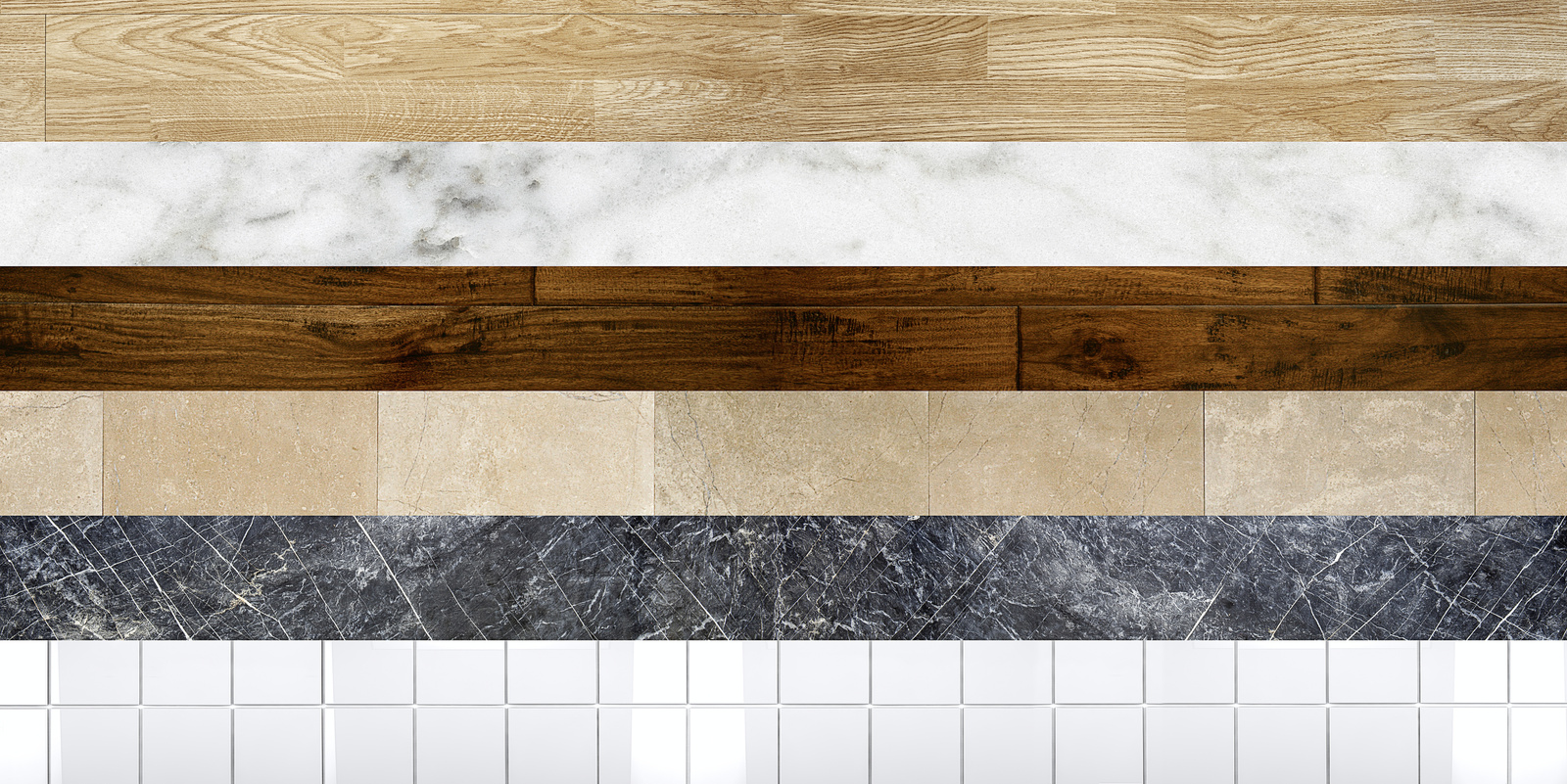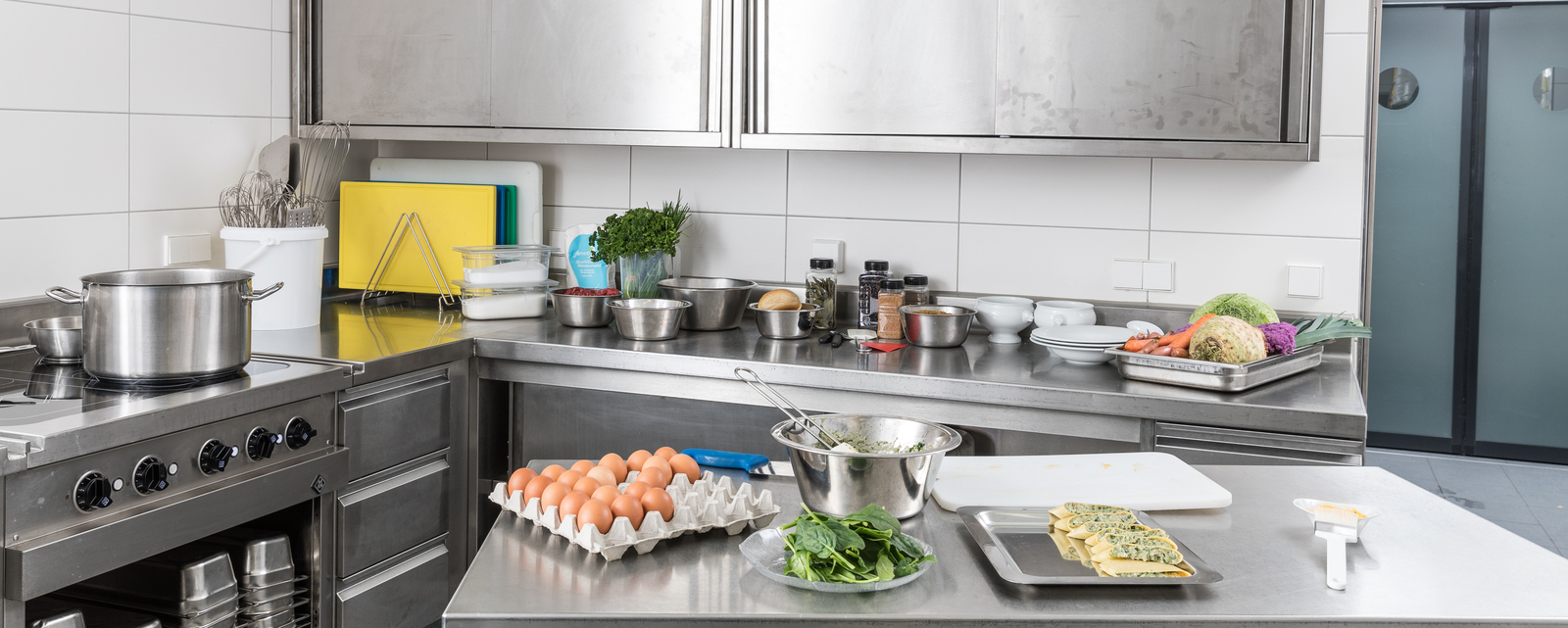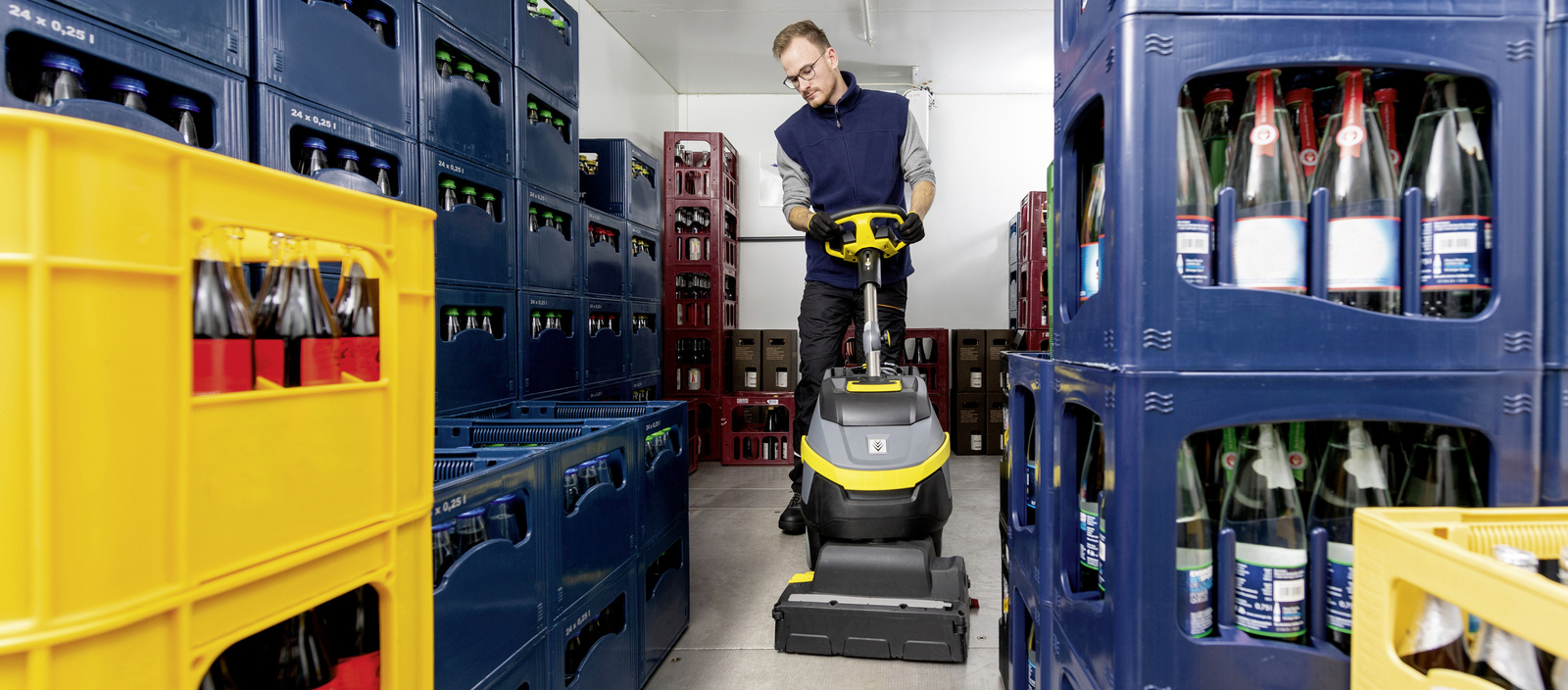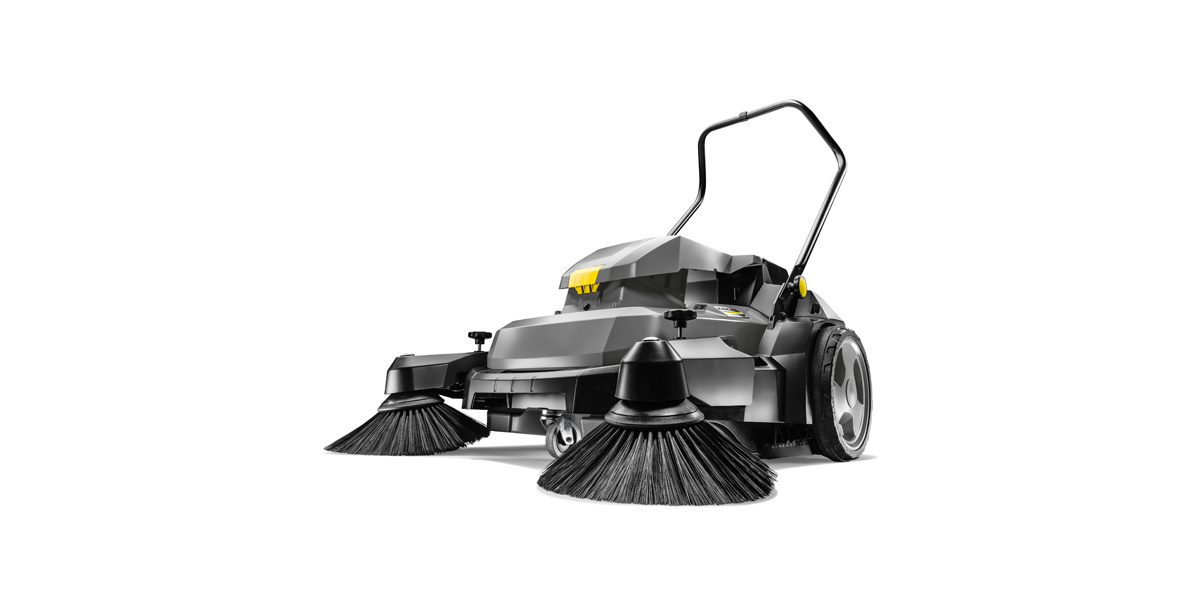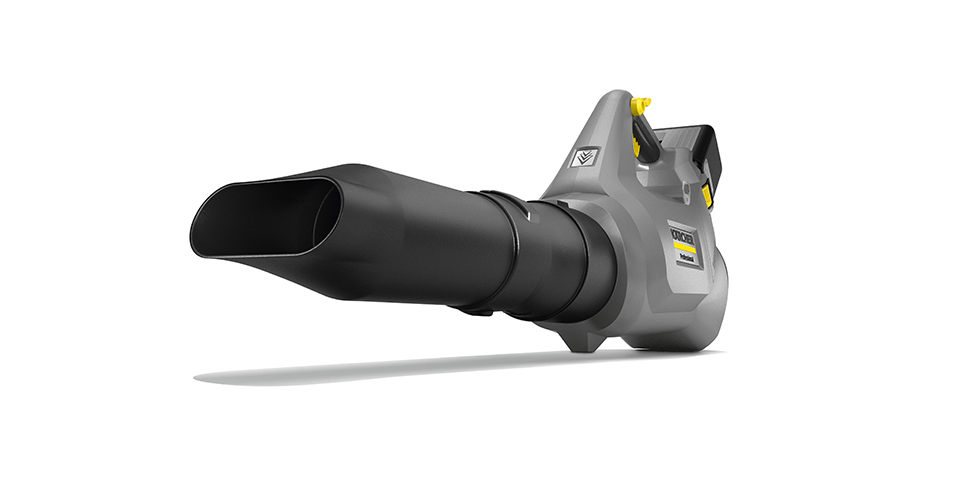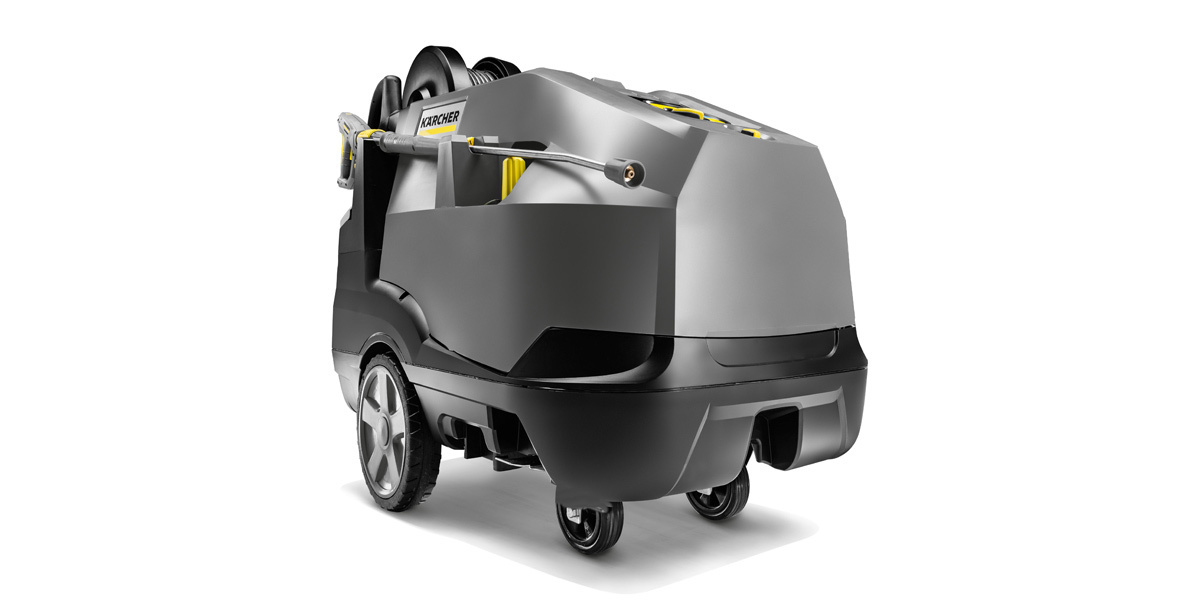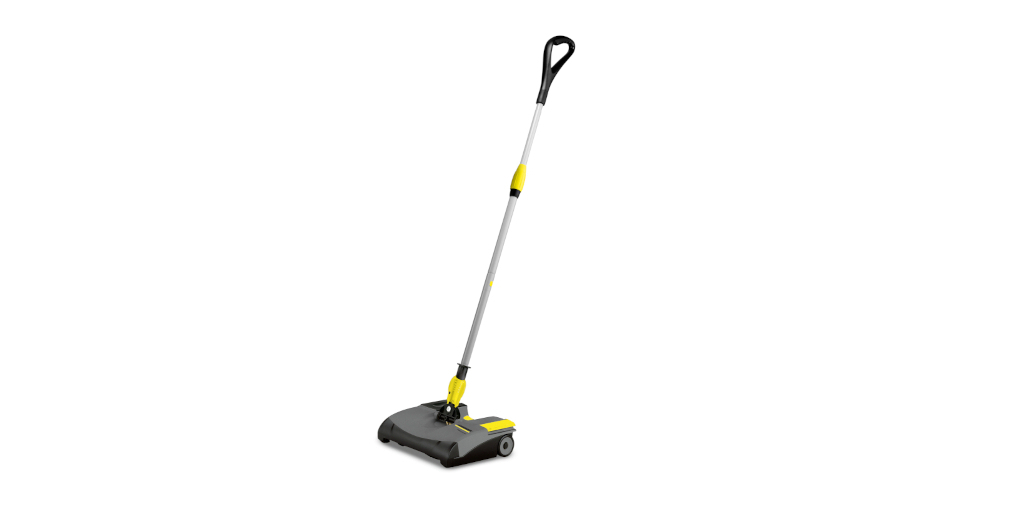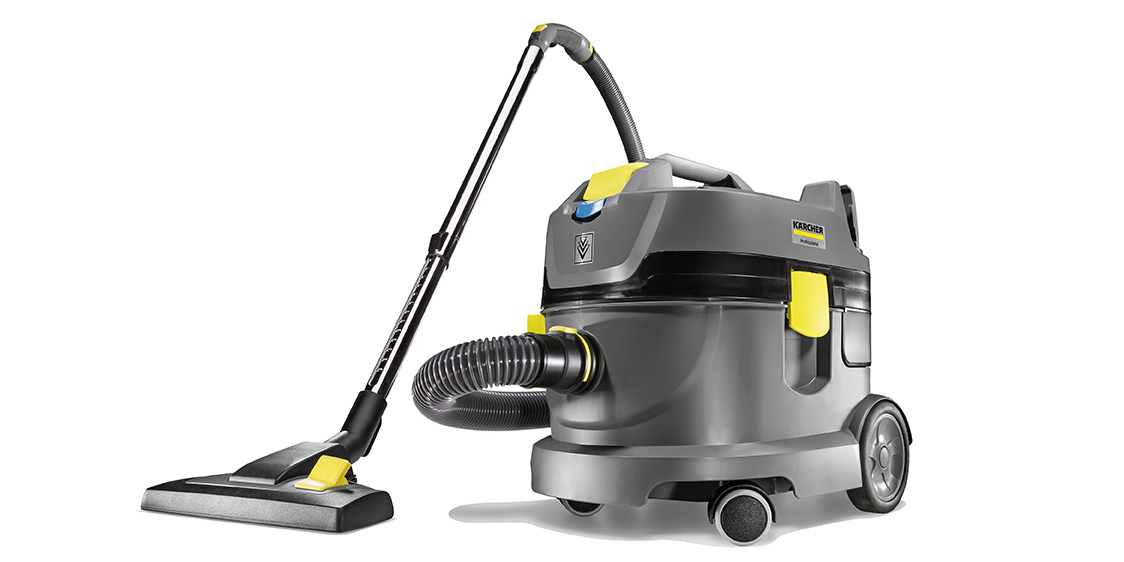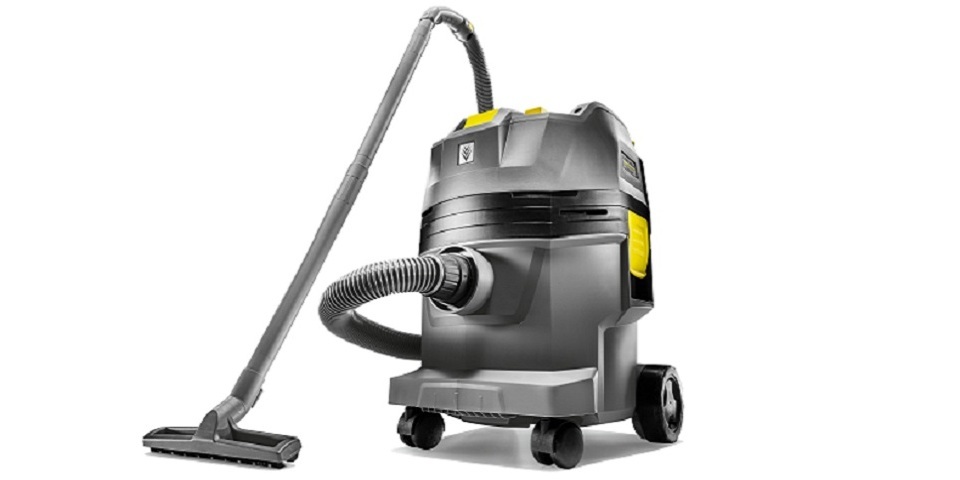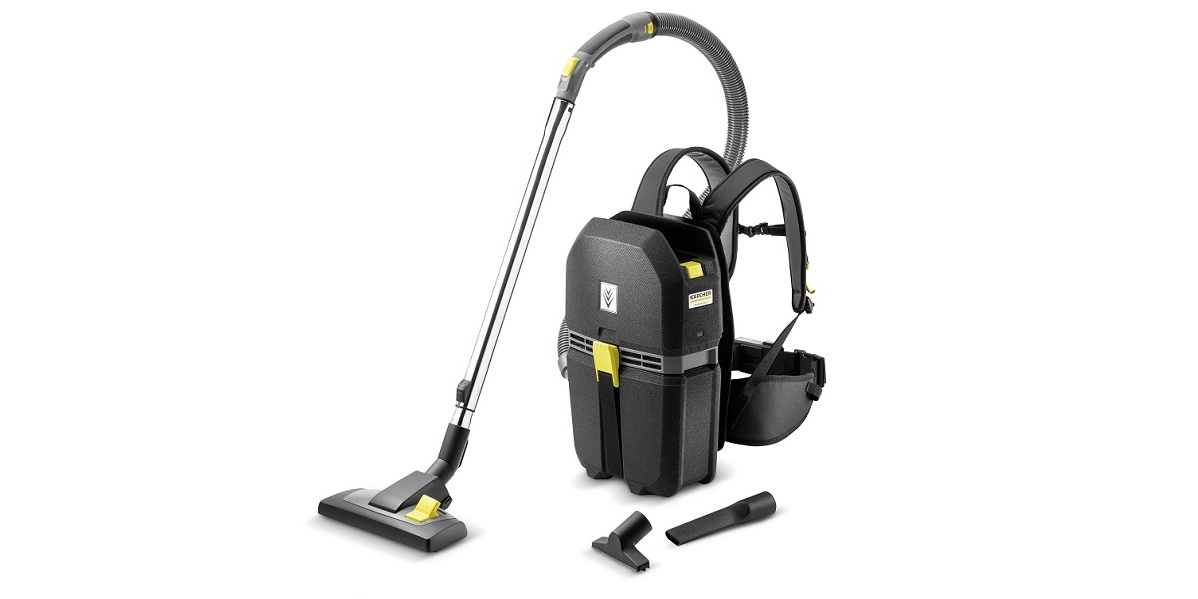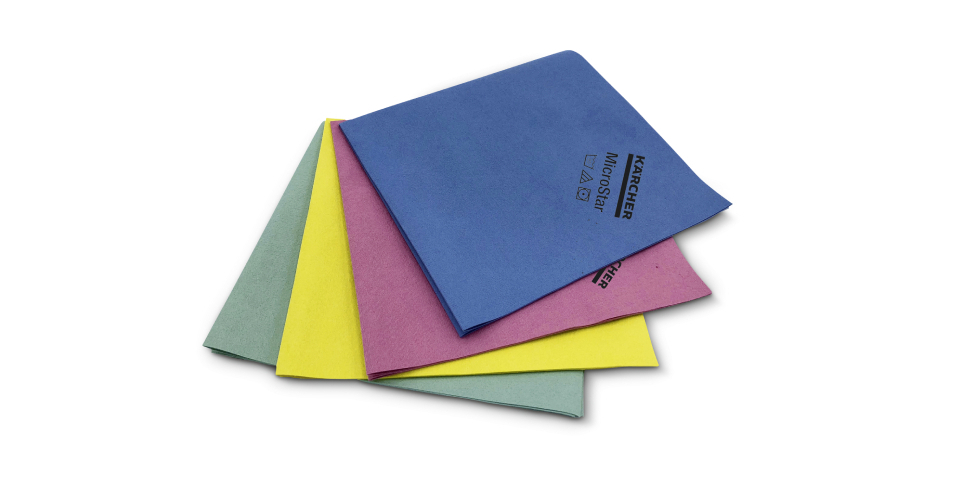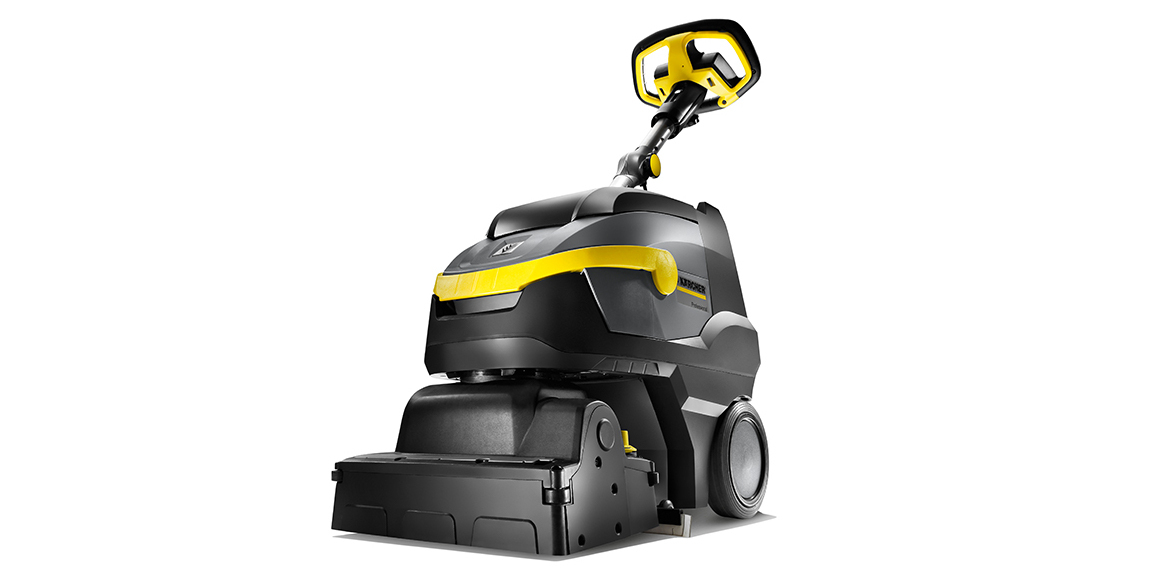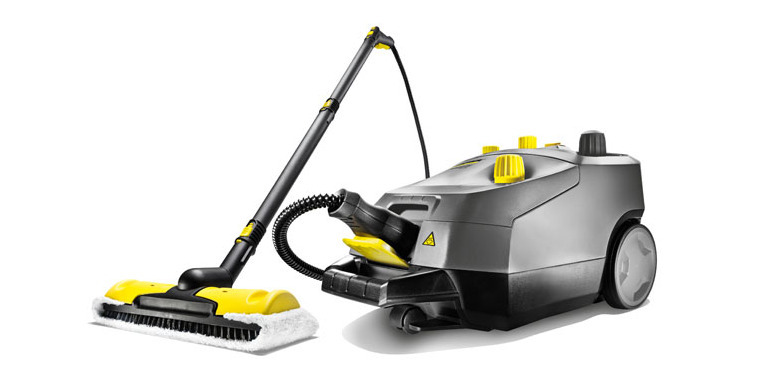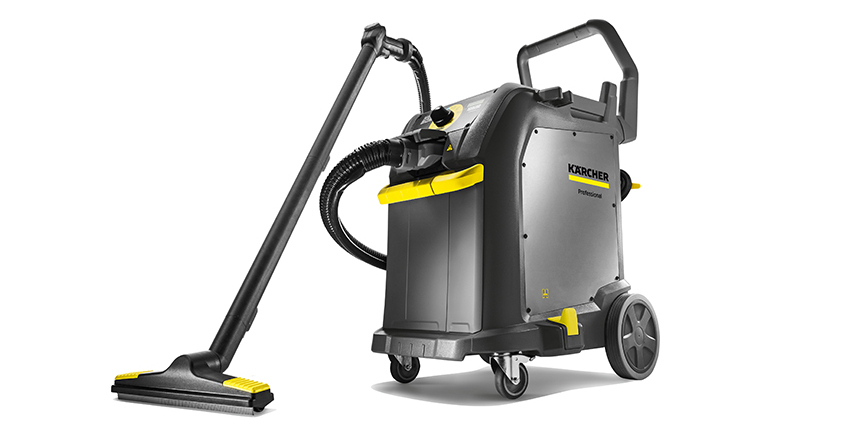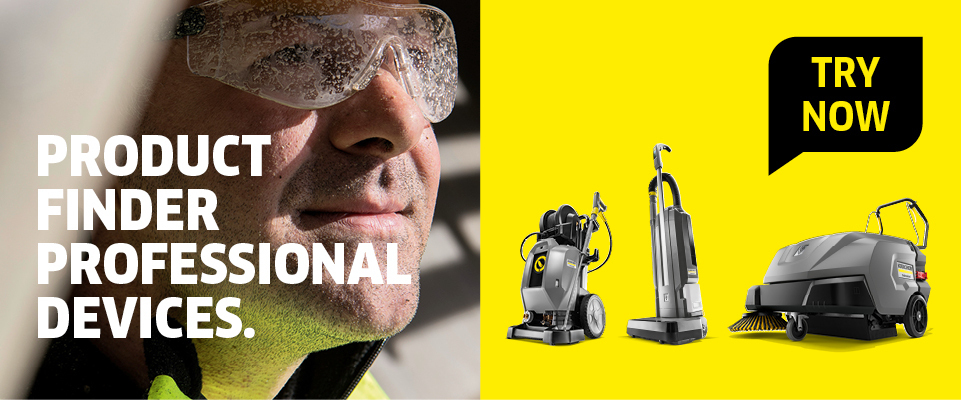Cleaning restaurants
Everyday working life in the hospitality industry is often hectic, with cost pressures high and staff in short supply. Yet guests' expectations are still high. To keep customers satisfied, it's not just good food that matters, but also the ambience. Cleanliness both front of house and back of house is essential to create the right atmosphere. Having the right technology and methods in place can help to complete the varied cleaning tasks efficiently and reduce the pressure on staff.
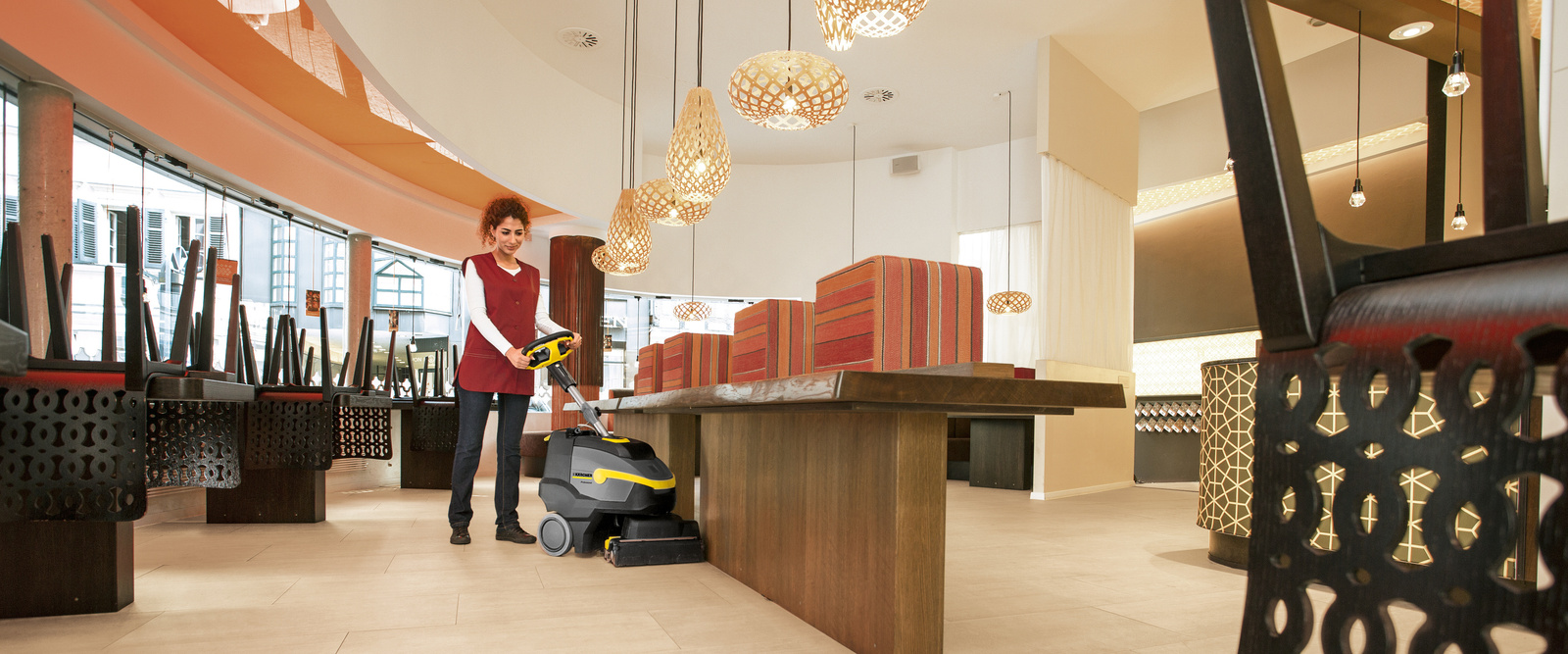
An inviting outside area
First impressions are crucial, so from the moments guests see the outside area, they should want to step inside. The added benefit: when the pavement seating, terrace and beer garden are clean, less dirt enters the restaurant in the first place. Cleanliness at the table is just as important, and here it is not only the appearance that reveals where corners have been cut.
The outside area as an advertisement: appealing whatever the weather
A push sweeper or ride-on machine is suitable for removing coarser dirt and debris from outdoor spaces. Battery-powered leaf blowers or leaf vacuums are a quiet and user-friendly option for removing fallen leaves from outdoor areas. As winter draws in, the right snow clearing solution must be chosen depending on the amount of snow and the site. In most cases, a snow shovel is sufficient for manual snow clearance. A small snow thrower with 26 hp can even handle larger amounts of snow.
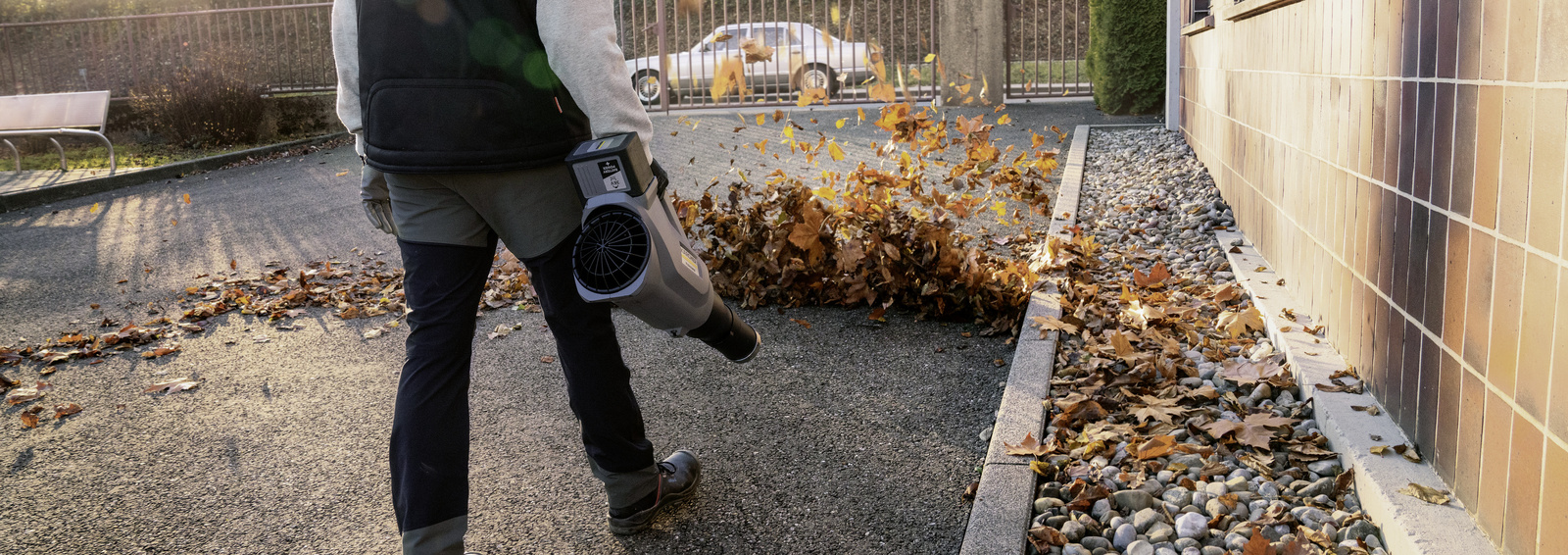
Outdoor facilities
Cleaning outside spaces is an important pillar of building cleaning services. Roads, paths and car parks need to be kept tidy, glass surfaces need to be cleaned, and smaller details, from cigarette bins to handrails on external stairs, must not be overlooked. Plus, the entrance area and dirt trap zone must be cleaned regularly. Well worth the effort: a positive first impression is created, the property value is preserved and the amount of cleaning work required indoors is reduced. A good cleaning concept and the right equipment help you to achieve your goal efficiently.
The entrance area: cleanliness in a bottleneck
The entrances to restaurants are often cramped, which is why cleanliness is so important there. High-quality, absorbent dust control mats give guests a welcoming reception while also minimising the amount of dirt brought in from outside. They can be easily cleaned of loose dirt and dust with an electric broom or an upright brush-type vacuum cleaner. A wet and dry vacuum cleaner is the right choice during wet weather conditions. Restaurant interiors are often laid with hard flooring, which needs to be cleared of coarse, visible dirt every day using dust mops and vacuum cleaners. Ingrained dirt can be removed quickly and efficiently with a spray mop system.
Tip 1 – Scrubber dryer for extra shine:
If polished stone floors are laid and the space is on the large side, it may be worth using a scrubber dryer to revive the floor's shine.
Tip 2 – Clean all entrances:
Not only the main entrance, but also delivery entrances and staff doors should be kept clean so that less dirt enters the interior.

Taking a seat at the table: the importance of look and feel
Once the customer has arrived at their table, it needs not only to look clean, but to feel clean too – this means the table, menu and chairs must not feel sticky. Another red flag for any guest is when the floor is sticky or covered in crumbs. Therefore, as soon as a table is vacated, all surfaces and touch points on the table and chairs must be wiped with a damp cloth. Microfibre cloths can remove dirt effectively thanks to their mildly abrasive properties. The tablecloth can be wiped with a cloth to remove loose dirt; if stained, however, it should be replaced. Finally, use a dust mop or electric broom to remove anything that has fallen from the table onto the chairs or floor. If drinks or other liquids have been spilt, a spray mop is the answer.
Intermediate cleaning with the right equipment
Both interim cleaning and daily cleaning before or after opening hours can be made more efficient with the right preparation and carefully chosen cleaning equipment.

Hitting targets through good preparation: efficient interim cleaning
Waiting staff and cleaning staff in the restaurant trade are invariably under extreme time pressure. This makes it all the more important to be well prepared. If cloths pretreated with water or detergent are kept to hand, any spills or unexpected soiling can be cleaned up quickly to maintain hygiene standards. The floors at the entrance or under the tables can be cleaned with a mop, a battery-powered dry vacuum cleaner or an electric broom. As a general rule, if the cleaning equipment is ready to hand, user-friendly and visually appealing, people will use it.


Daily cleaning in the interior: early bird or night owl
Day-to-day cleaning is carried out either before or after opening hours. However, cleaning the restaurant after closing time is less demanding, because stubborn deposits have not yet had time to get embedded. Whether before or after service, however, any loose or ingrained dirt must first be removed from each table. If a detergent has been used during the day, only water may be used in the evening. This is because the water also removes detergent residues, preventing the surfaces from feeling sticky.
Pretreated microfibre cloths are an ideal choice owing to their abrasive properties, not to mention being quick to use. The chairs and all touchpoints, such as the backrest, armrests and the surfaces to the sides underneath the chair, should be wiped down with a damp cloth. Most materials such as wood, leather and plastic can be cleaned using damp methods. Any marks in textiles can be treated with a stain remover.
Tip 1 – Work from the edge to the middle:
To avoid spreading the stain further into the fabric when performing spot removal, always work from the outside in.
Tip 2 – Clean all surfaces:
During daily cleaning, all other surfaces such as door handles, window sills and countertops must also be cleaned and, if necessary, disinfected.
Efficient floor cleaning
Having the right equipment takes the hard work out of maintenance cleaning of floors – to the delight and relief of staff. Even with the very best care, floors will occasionally still need to be deep-cleaned. The right equipment and method vary depending on the floor covering.
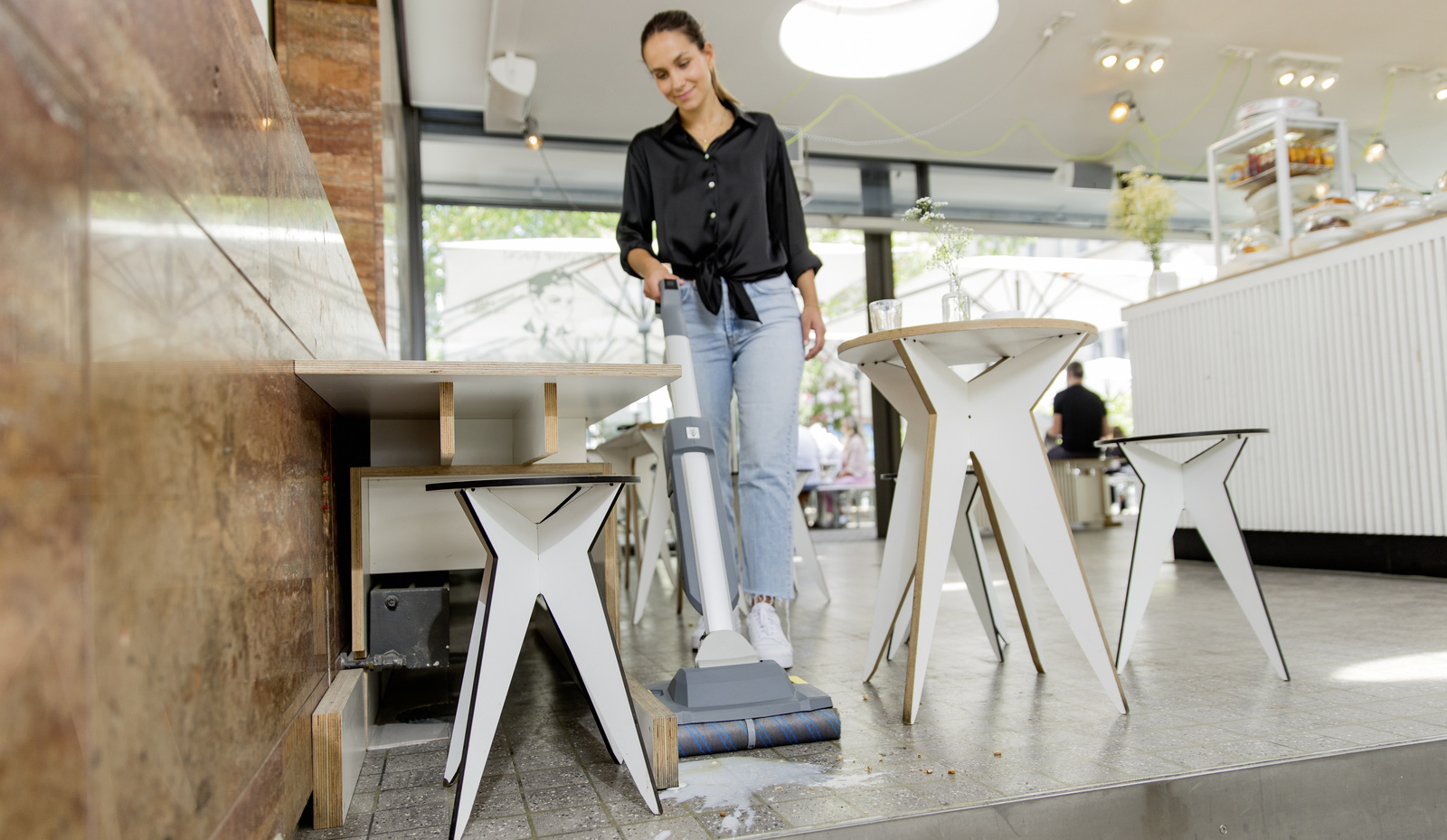
Hard floors or carpets: clean efficiently with a vacuum cleaner and/or mop
Once tables and chairs have been cleaned, hard floors and carpets can be passed over with a vacuum cleaner to remove any fallen dirt and debris. When it comes to wet cleaning hard floors, a scrubber dryer or microfibre mop system is the answer. If the latter, the pretreated method is recommended, since it removes the need to repeatedly immerse and wring out a dirty mop over and over in the same bucket, which in turn saves the cleaning team time and effort.
Keep an eye on it: deep cleaning the floors
Even if floors are cleaned on a daily basis to prevent dirt from becoming embedded or ingrained, it can still be necessary to give them a deep clean between two and four times a year. Otherwise, floors start to smell unpleasant, feel sticky or look worn and become harder to keep clean. The necessary equipment and method must be selected depending on the type of floor.
- Carpeted floors call for interim cleaning with an iCapsol detergent or alternatively deeper spray extraction, preferably with iCapsol detergent too. When it comes to deep cleaning carpets, there are machines that combine the spray extraction method with the roller brush technique.
- For wooden floors, the type of wooden floor is decisive. For a deep clean of oiled floors, options include scrubber dryers with a roller scrubbing head, double roller system with contra-rotating rollers and red or beige pads. To sand the sealant on either sealed or oiled floors, the answer is a single-disc machine with suction or an orbital single-disc machine. Waxed floors, on the other hand, need to be treated with a dry pad to mechanically remove the wax residue.
- Hard floors can be cleaned using a scrubber dryer and a deep cleaner.

Tip – Remove wax residue:
If required, any wax residue left behind on waxed wooden floors can be removed using a parquet deep cleaner.
Cleaning floor coverings
Whether carpeting in a hotel corridor, cement screed in a production hall or wooden flooring in a school building, there are countless floor coverings that are suitable for different loads and ensure safety through properties such as anti-slip design or studs. Cleaning floor coverings is important in some areas to ensure hygiene, while in other areas the focus is on appearance. In any case, well-maintained floor coverings have a longer service life and therefore need to be replaced less frequently. Through regular maintenance cleaning, even the need for labour-intensive deep cleans can be delayed.
A clean restaurant experience: all in the colours and the details
While cleanliness is of course important everywhere in restaurants, in the toilets it is absolutely non-negotiable. Here, colours can play a major part in preventing the spread of germs. The little details make all the difference when it comes to making sure customers feel at ease.
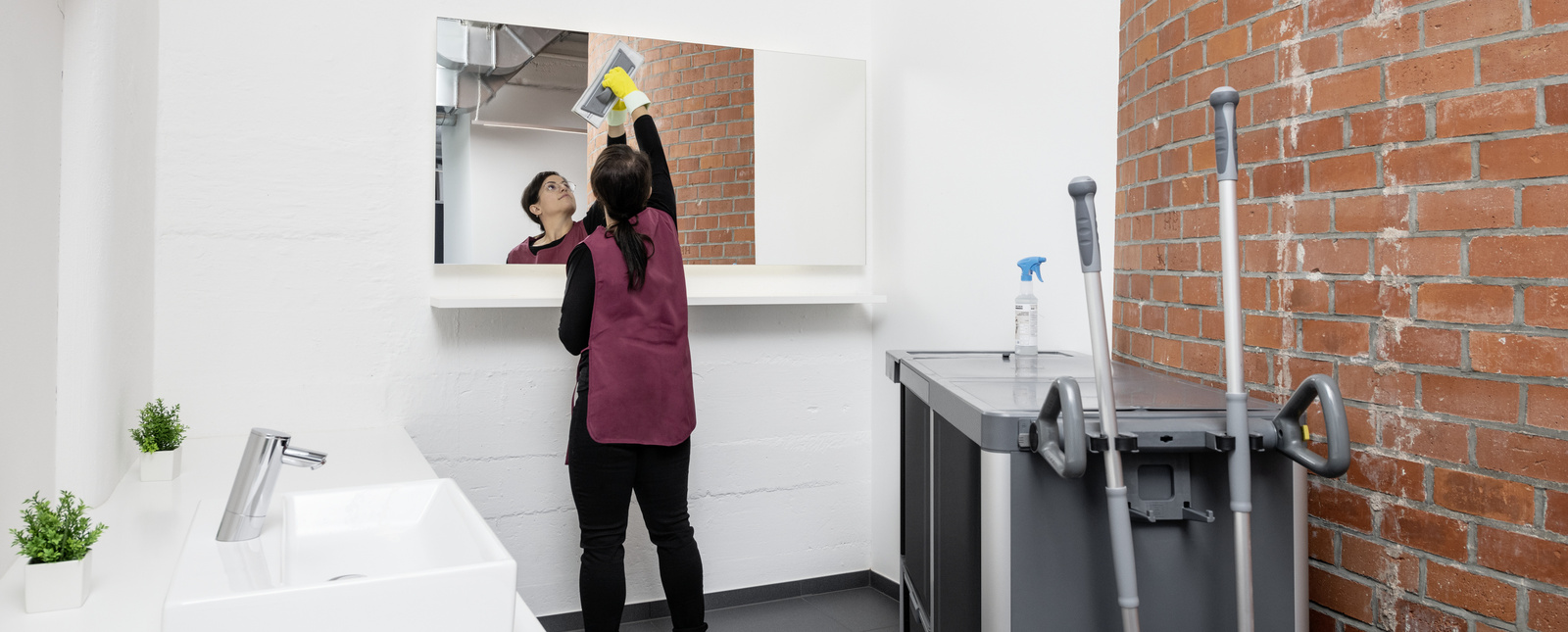
When nature calls: cleanliness that builds a sense of trust
Nothing puts you off your dinner quite like dirty toilets. This is precisely why toilet facilities should be cleaned thoroughly at least once a day either before or after opening hours and as and when necessary in between. Besides the toilets themselves, the baby changing table is a sensitive area, so therefore needs to be cleaned daily and disinfected as necessary. The cleaning staff should also clean mirrors, shelves and washbasins at least once a day.
The colour-coding method can be used to prevent the spread of germs when cleaning toilet facilities. The different colours indicate their different areas of application. Urinals, toilets and splash areas are always cleaned with red cleaning textiles. Yellow textiles are used for all other areas in the toilet facilities. The different colours ensure the safety of the cleaning staff. To prevent streaks from forming when cleaning the mirrors, we recommend using suitable microfibre cloths together with a ready-to-use glass cleaner.
To ensure that staff have quick access to the cleaning trolley and cleaning equipment, these should be located close to the point of use. However, this should still be somewhere guests cannot access, because a bucket filled with dirty water or used towels is not a pretty sight for diners.

Tip 1 – Check the toilet brush:
When cleaning the toilet, checks should also be made to ensure the toilet brush is clean.
Tip – Continuous supply:
During opening hours, supplies such as hand towels, soap or toilet paper must be checked and replenished as needed and the rubbish bins must also be emptied. A pleasant fragrance, such as a subtle reed diffuser, adds a finishing touch.
Cleaning toilet facilities and washrooms
There are many reasons why careful cleaning is required in toilet facilities and washrooms: depending on the setting, toilets, showers and changing rooms in office buildings, production facilities, hotels, restaurants, sports halls or shopping centres are used by many people. This inevitably leads to people's skin coming into contact with various different surfaces that have been touched by practically all users of the facilities – including door handles, taps or toilet flush buttons. Consequently, microorganisms can pass from one person to the next. This must be prevented by means of defined cleaning sequences.
Hygiene in the hospitality sector
As soon as food is involved, hygiene is the be-all and end-all. With the right equipment, the restaurant kitchen and cold store can be cleaned with efficiency, taking the hassle out of compliance with the strict requirements of local or international guidelines, such as HACCP (Hazard Analysis Critical Control Points).
Cleanliness in the kitchen (1): wall tiles
When combined with foam jets or cup foam lances using a compatible foam detergent, a high-pressure cleaner is just the answer for the daily cleaning of wall tiles in the kitchen. It is important to alternate between acidic and alkaline foam detergents to reliably eliminate the breeding grounds of microorganisms. It must be noted that tile grouts containing cement are sensitive to acids. To avoid damaging the grouting, the tiles should be rinsed before they are cleaned with acidic agents.
Cleanliness in the kitchen (2): for hygienically clean kitchen appliances and more
Steam cleaners are an ideal tool for keeping kitchen appliances and utensils hygienically clean. The steam accelerates out of the nozzle at 170 km/h in very fine drops at a high temperature of 100 °C and a pressure of 4 to 8 bar. This enables the steam to get into places that a cloth or brush would struggle to reach. The edges of dishwasher front panels and grooved surfaces are therefore left hygienically cleaned – and all without any need for chemicals.
Cleanliness in the kitchen (3): cleaning floors
To minimise the risk of slipping, commercial kitchens are typically laid with textured tiles with studs. One drawback of this is that grease and food spills get caught in the recesses between the studs and deposits build up over time. One efficient way of loosening the dirt is to use high pressure in the form of a surface cleaner with a rotating nozzle bar and slightly offset power nozzles. Alternatively, orbital machines or scrubber dryers in a roller design are effective options for cleaning floors. However, roller machines are much easier to operate and suck the dirty water straight back up. Best of all, the high rotation speed makes the rollers practically self-cleaning, since the dirt simply cannot stick to them.
Cleanliness in the kitchen (4): the cold store
Besides cleaning the kitchen, cleaning the cold store should also be a regular feature on the programme. Maintenance cleaning is undertaken while the cold store is still switched on, the advantage of this being that the cold chain is not interrupted. Pretreated cloths or microfibre mops can remove visible dirt with ease thanks to their abrasive properties. A small scrubber dryer is also a very effective option for cleaning the floor. While cleaning is underway, the door of the cold store should remain closed so as not to reduce the cooling performance. It is therefore especially important that cleaning staff have the right personal protective equipment (PPE), such as a special thermal suit, safety goggles and gloves. What's more, the cold store must be sufficiently ventilated.
Tip – Use steam cleaners in cold stores:
When cold store temperatures are above freezing, steam cleaners are also a good choice for a hygienic clean in hard-to-reach areas such as the rubber seals on the door. When the cold store is given a deep clean, the refrigeration is switched off and all food is moved to another cold store or into a refrigerated container.
Cleaning kitchens
Wherever food is cooked, there will be stubborn stains. Grease and food residues must be systematically removed in accordance with the HACCP guidelines in order to eliminate breeding grounds for microorganisms. What can high-pressure cleaners, surface cleaners, steam cleaners, scrubbers or scrubber dryers do? What specifics need to be considered when using them? And what should disinfection look like? Here is an overview.
Hygiene in the cold store
Low temperatures, high relevance: cold stores can be found in numerous companies – and where they are found, they are generally integral to operational processes. In hotels and restaurants, in industrial production plants or in supermarkets, cold stores provide the correct conditions for storing perishable and temperature-sensitive goods. For the cold store to function perfectly, it requires specialist professional cleaning that reflects the special conditions.
Suitable products for your area of application
Find a wide range of technology at lightning speed – with the Kärcher Professional product finder
In no time at all, we'll show you the exact Kärcher Professional machine that best suits your specific cleaning task.

